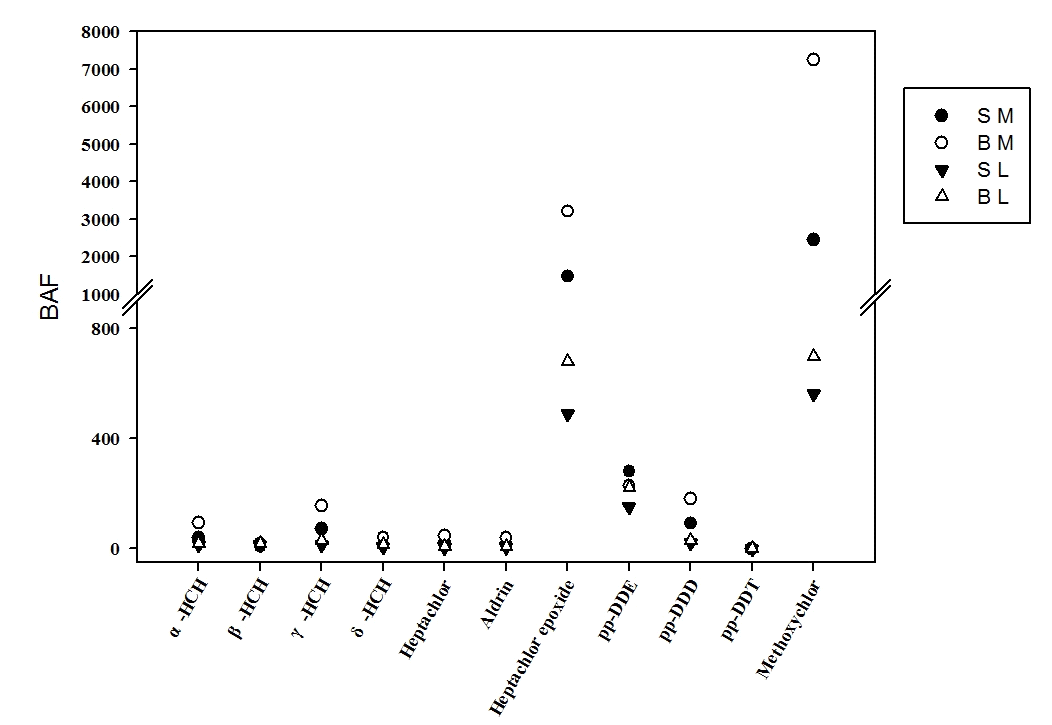中科院武汉植物园评估食用鱼体内污染物对人体致癌风险
有机氯农药和重金属的大量使用对环境造成了严重危害,而且这两类化合物在环境中非常稳定,难降解并容易沿食物链传递,最终对人类健康造成极大的危害。鲢鱼和鳙鱼是两类重要的淡水可食用鱼类,其污染状况与人们的身体健康息息相关。
中国科学院武汉植物园污染生态学科组博士研究生崔莉莉在研究员王俊指导下,以鲢鱼和鳙鱼为研究对象,调查分析了有机氯农药和重金属在两种鱼体内的分布、富集及可能对人体造成的致癌风险进行了评估。结果显示,两种鱼体内的总有机氯农药含量在2.04-189.04 ng·g−1 (湿重) 之间,且更容易在鳙鱼中富集;鲢鱼和鳙鱼体内的总重金属含量分别是352.48和345.20 mg·kg−1 (干重),容易在肝和肠中富集。致癌风险评估结果显示,有机氯农药引起的致癌风险可以忽略,但是重金属尤其是砷和铬可能引起较高的致癌风险,应当引起重视。
该研究得到了湖北省自然科学重点基金 (NO. 2014CFA114) 和中国科学院百人计划 (NO. Y329671K01) 择优基金支持,相关成果在环境领域期刊Environmental science and Pollution Research上发表。

鱼体内有机氯农药的生物富集系数 (B: 鳙鱼S: 鲢鱼 M: 肌肉样品 L: 肝样品)

鳙鱼 (B)和鲢鱼 (S)各组织内的重金属含量 (mg·kg-1, 干重
原文链接:
Concentrations, bioaccumulation, and human health risk assessment of organochlorine pesticides and heavy metals in edible fish from Wuhan, China
原文摘要:
The objective of this study was to determine concentration and bioaccumulation of organochlorine pesticides and heavy metals in edible fish from Wuhan, China, in order to assess health risk to the human via fish consumption. Two edible fish species (Aristichthys nobilis and Hypophthalmichthys molitrix) were collected and analyzed for 11 organochlorine pesticides (OCPs) and eight heavy metals (HMs). Concentrations of ∑HCHs, ∑DDTs, and ∑OCPs in fish samples were in the range of 0.37–111.20, not detected (nd)–123.61, and 2.04–189.04 ng g−1 (wet weight), respectively. Bioaccumulation factors (BAFs) of OCPs in bighead carp (A. nobilis) were higher than those in silver carp (H. molitrix). Concentrations of ∑HMs in bighead carp and silver carp were 352.48 and 345.20 mg kg−1 (dw), respectively. Daily exposure of OCPs and HMs for consumers was estimated by comparing estimated daily intake (EDI) with different criteria. The results revealed that the EDIs in our study were all lower than those criteria. Target hazard quotient (THQ) and risk ratio (R) were used to evaluate non-carcinogenic and carcinogenic risks, respectively. As regard to non-carcinogenic effects of the contaminants, hazard quotients (THQ) of OCPs and HMs were both lower than 1.0, implying negligible non-carcinogenic risk via fish consumption in study area. Nevertheless, in view of carcinogenic effects of the contaminants, the total value of risk ratio (R) of OCPs was lower than the threshold of tolerable risk while the total value of risk ratio (R) of HMs was higher than the threshold of tolerable risk due to the high carcinogenic risk ratios of As and Cr, indicating high carcinogenic risks via fish consumption. The results demonstrated that HMs in edible fish from Wuhan, China, especially As and Cr required more attention than OCPs.
DOI:10.1007/s11356-015-4752-8
作者:王俊

